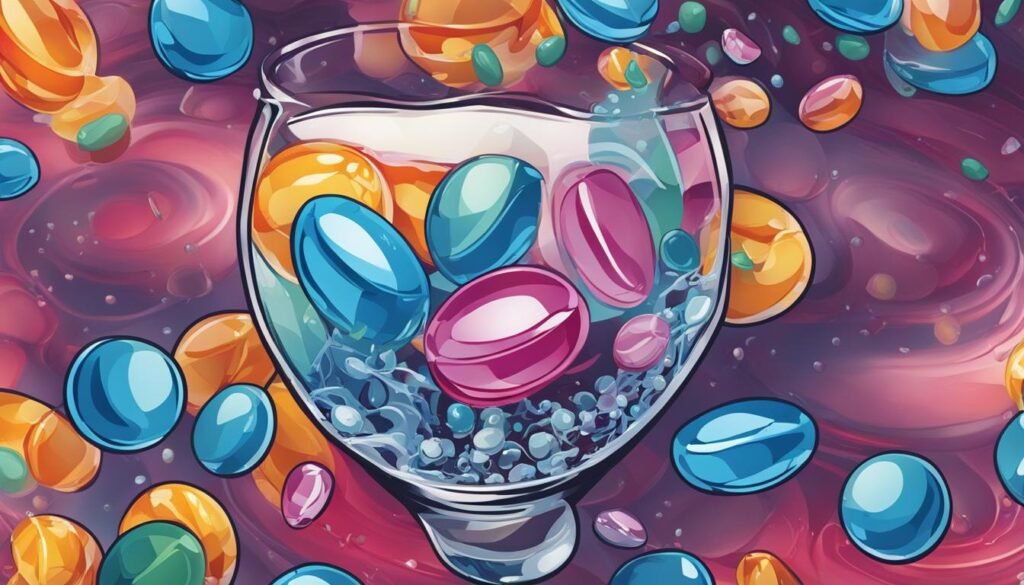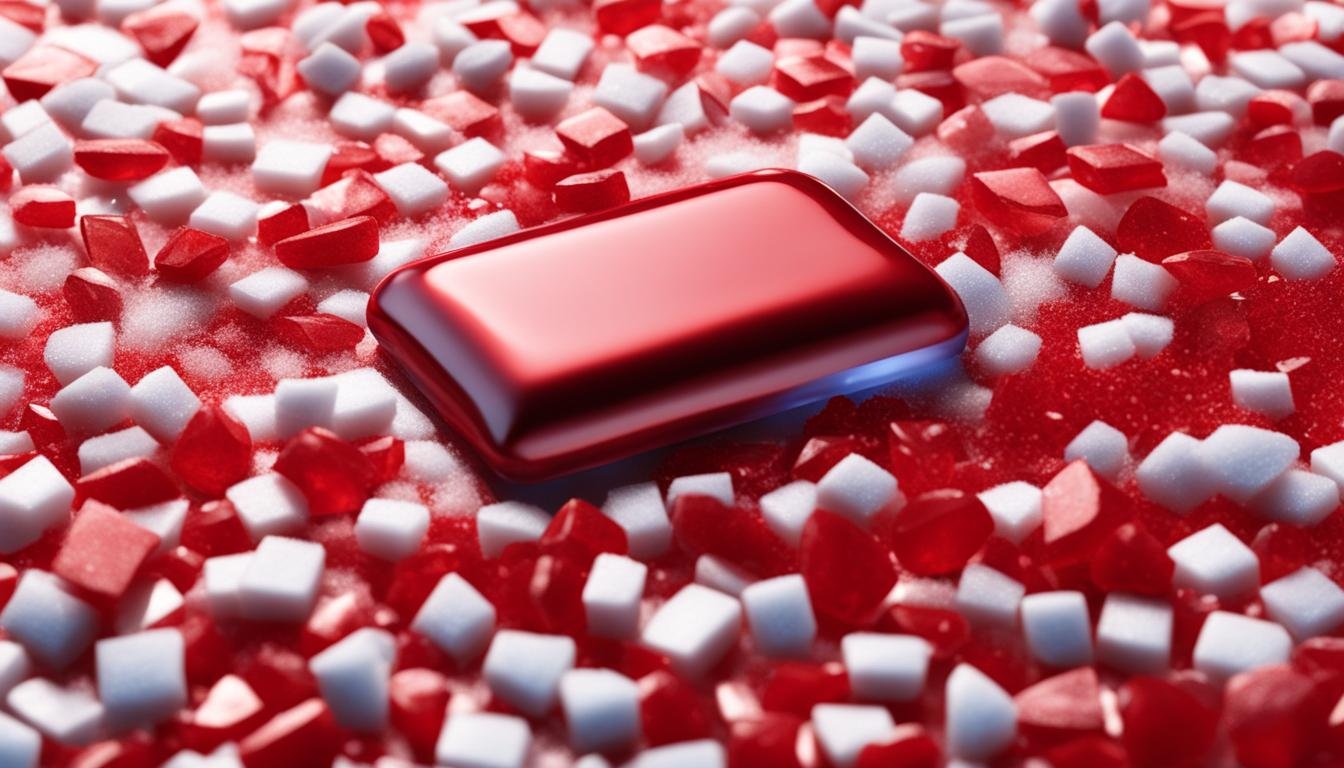Advil, a popular pain reliever, has a surprising sweet taste. But why does it taste sweet? Let’s explore the reasons behind this unexpected flavor.
Key Takeaways:
- Advil tastes sweet due to the candy-coating on the tablets.
- The sweet taste lasts for approximately 45 seconds before transitioning to a chalky and flavorless taste.
- The candy-coating adds an enjoyable element to the overall experience of taking the medication.
- Remember, Advil is not candy and should only be taken as directed.
The Four Stages of Advil Flavor Spectrum
Advil’s taste experience can be best understood by breaking it down into four distinct stages. These stages offer a comprehensive understanding of the flavor spectrum that unfolds while consuming Advil.
- Stage 1: Lightly Sweet – The initial stage of Advil’s flavor journey is characterized by a delightful, candy-like sweetness. This flavor is experienced for approximately 45 seconds and is exclusive to the coated Advil tablets. It adds a touch of sweetness to the overall taste, making it more enjoyable.
- Stage 2: Vaguely Banana-like – After the sweet phase, the flavor takes an intriguing turn, resembling a faint banana-like taste. This stage lasts for about 11 seconds, offering a unique twist to the overall experience.
- Stage 3: Chalky and Flavorless – The third stage of the flavor spectrum brings a transition to a chalky and flavorless phase, lasting for approximately 8 seconds. This stage serves as a neutral interlude between the initial sweetness and the ensuing bitterness.
- Stage 4: Horrendous Bitterness – The final stage of Advil’s flavor journey is marked by a powerful, taste-bud-destroying bitterness that can linger for up to 20 minutes. This bitter aftertaste is a distinctive characteristic of Advil and should be expected after consuming the medication.
Understanding the four stages of Advil’s flavor spectrum is essential for those consuming the medication. It allows individuals to anticipate and be aware of the various taste experiences that accompany the consumption of Advil tablets. However, it is important to note that while the lightly sweet phase adds a moment of enjoyment, Advil should never be consumed like candy and should always be taken as directed.

Advil’s Taste and Pesach Concern
When it comes to dietary restrictions, it’s important to consider the ingredients in the medications we take. This is especially true during religious observances like Pesach (Passover). While Advil itself does not pose a Pesach concern, it’s essential to be aware of the different varieties and their coatings.
The candy-coated Advil tablets, which provide a lightly sweet and candy-like flavor for about 45 seconds, contain pharmaceutical glaze (shellac) and sucrose. These ingredients do not pose a Pesach concern. However, other versions of Advil, such as the “Film-Coated” tablets and caplets, have coatings that may include Pesach-sensitive ingredients like mannitol and flavor. It’s important to carefully read the ingredient panel of any medication to ensure it aligns with your dietary restrictions and personal preferences.
When in doubt, consulting with a trusted religious authority or a healthcare professional can provide further guidance on which medications are suitable for Pesach.
The Importance of Checking Ingredient Panels
Understanding the ingredients in the medications we take is crucial for individuals with dietary restrictions or allergies. By checking ingredient panels, we can make informed decisions about the products we consume. This holds true not only during Pesach but also throughout the year.
“By being mindful of the coatings and ingredients in medications, we can ensure that our health and religious observances align harmoniously.”
Personal Preferences and Health
While it’s essential to consider dietary restrictions, it’s equally important to prioritize your health. If a specific medication is necessary for your well-being, alternatives or adjustments may be available. Healthcare professionals can provide guidance on suitable options that align with both your health needs and personal preferences.
- Always check the ingredient panel of medications for any potential allergens or dietary concerns.
- Consult with a trusted religious authority or a healthcare professional for specific guidance during religious observances.
- Balance dietary restrictions with health needs, exploring alternative medications if necessary.
Remember, maintaining your well-being should always be a top priority, and with the right information, you can make informed decisions about the medications you take.
Conclusion
In conclusion, the sweet taste of Advil is a result of the candy-coating on the tablets. This coating provides a lightly sweet and candy-like flavor that lasts for about 45 seconds, adding an enjoyable element to the overall taste experience. However, it is important to note that the sweetness quickly fades, and the taste transitions to a chalky and flavorless texture, followed by a horrendous, bitter aftertaste that can linger for up to 20 minutes.
While the candy-coating is not explicitly advertised by Advil, it is crucial to remember that Advil is not candy and should be taken as directed. The sweet taste should not encourage consumption like candy, as Advil is a medication meant for pain relief. It is essential to follow the recommended dosage and use Advil responsibly.
So, the next time you wonder why Advil tastes sweet, remember that it’s the candy-coating on the tablets that provides this unique taste experience. Always prioritize the intended use of Advil as a pain reliever and take it as directed to ensure safe and effective relief.
FAQ
Why does Advil taste sweet?
The sweet taste of Advil is due to the candy-coating on the tablets. The coating provides a lightly sweet and candy-like flavor that lasts for about 45 seconds.
What are the different stages of Advil’s flavor spectrum?
The taste experience of Advil can be divided into four distinct stages. The first stage is the lightly sweet phase, followed by a phase with a vague banana-like flavor. This is then followed by a chalky and flavorless phase, and finally, a horrendous bitterness that can linger for up to 20 minutes.
Why is Advil candy-coated?
The candy-coating on Advil tablets is designed to enhance the overall experience of taking the medication. It adds a sweet taste that provides a brief moment of enjoyment before the bitterness of the medicine takes over.
What is the science behind Advil’s sweet taste?
The sweet taste of Advil is primarily due to the candy-like coating on the tablets, which contains sucrose. The taste sensation is believed to be pH-dependent, with the sweetness fading as the tablet dissolves and the pH changes. Further research is needed to fully understand the mechanism behind Advil’s sweet taste.
Does Advil’s candy coating pose a Pesach (Passover) concern?
The coating of Advil tablets, which contains pharmaceutical glaze (shellac) and sucrose, does not pose a Pesach concern. However, other varieties of Advil, such as the “Film-Coated” tablets and caplets, may contain Pesach-sensitive ingredients and should be avoided during Passover.
Why is it important to remember that Advil is not candy?
While Advil has a sweet taste due to its candy-coating, it is essential to remember that Advil is a medication and should only be taken as directed. It is not intended to be consumed like candy.

